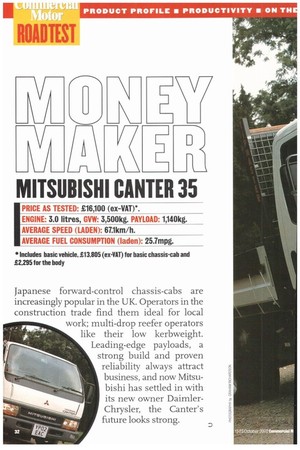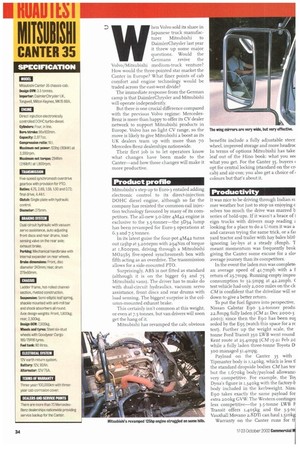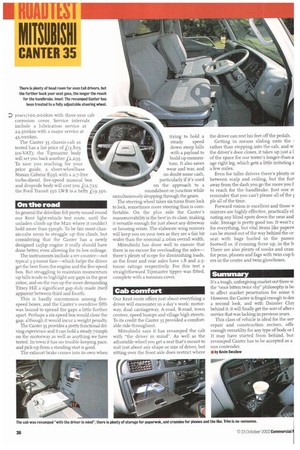MITSUBISHI CANTER 35
Page 32

Page 34

Page 36

If you've noticed an error in this article please click here to report it so we can fix it.
IPRICE AS TESTED: £16,100 (ex-VAT)*. ENGINE: 3.0 litres, GM: 3,500kg. PAYLOAD: igokg. AVERAGE SPEED (LADEN): 67.1km/h.
AVERAGE FUEL CONSUMPTION (laden): 25Impg.
* Includes basic vehicle. £13,805 (ex-VAT) for basic chassis-cab and £2,295 for the body
Japanese forward-control chassis-cabs are increasingly popular in the UK. Operators in the construction trade find them ideal for local work; multi-drop reefer operators like their low kerbweight. Leading-edge payloads, a strong build and proven reliability always attract business, and now Mitsubishi has settled in with its new owner DaimlerChrysler, the Canter's future looks strong. lArhen Volvo sold its share in Japanese truck manufacturer Mitsubishi to DairnlerChrysler last year it threw up some major questions. Would the Germans revive the Volvo/Mitsubishi medium-truck venture? How would the three-pointed star market the Canter in Europe? What finer points of cab comfort and engine technology would be traded across the east-west divide?
The immediate response from the German camp is that DaimlerChrysler and Mitsubishi will operate independently.
But there is one crucial difference compared with the previous Volvo regime: MercedesBenz is more than happy to offer its CV dealer network to support Mitsubishi products in Europe. Volvo has no light CV range, so the move is likely to give Mitsubishi a boost as its UK dealers team up with more than 70 Mercedes-Benz dealerships nationwide.
Their first job is to let operators know what changes have been made to the Canter—and how those changes will make it more productive.
Product profile
Mitsubishi's step up to Euro-3 entailed adding electronic control to its direct-injection DOE-IC diesel engine, although so far the company has resisted the common-rail injection technology favoured by many of its competitors. The all-new 3.0-litre 4M42 engine is exclusive to the 3.5-tonner—the 3034 lump has been revamped for Euro-3 operations at 6.3 and 7.5 tonnes.
In its latest guise the four-pot 4M42 turns out 12,5hp at 3,2oorpm with 294Nm of torque at 1,800rpm. driving through a Mitsubishi M025S5 five-speed synchromesh box with fifth acting as an overdrive. The transmission allows for a side-mounted PTO.
Surprisingly, ABS is not fitted as standard (although it is on the bigger 63 and 75 Mitsubishi vans). The driver has to make do with dual-circuit hydraulics, vacuum servo assistance, front discs and rear drums with load sensing. The biggest surprise is the column-mounted exhaust brake.
This certainly isn't common at this weight, or even at 7.5 tonnes, but van drivers will soon get the hang of it.
Mitsubishi has revamped the cab; obvious
benefits include a fully adjustable steer. wheel, improved storage and more headroc In terms of options Mitsubishi has take leaf out of the Hino book: what you set what you get. For the Canter 35, buyers opt for central locking (standard on the cri cab) and air-con; you also get a choice of colours but that's about it.
Productivity
It was nice to be driving through Indian st mer weather but just to stop us enjoying c selves too much the drive was marred b series of hold-ups. If it wasn't a brace of eign trucks with drivers map reading looking for a place to do a U-turn it was a and caravan trying the same trick, or a fat yard tractor and trailer with hay bales blitF ignoring lay-bys at a steady r8mph. T meant momentum was frequently brok giving the Canter some excuse for a sic), average journey than its competitors.
In the event the laden run was complete, an average speed of 41.7mph with a f return of 25.7mpg. Running empty impro consumption to 32.5mpg at 42.2mph. IC test vehicle had only 2,000 miles on the ck CM is confident that the driveline will se down to give a better return.
To put the fuel figures into perspective, Nissan Cabstar E 90 3.2-tonner produ 22.8mpg fully laden (CM ax Dec 200 0-3 zoo* since then the E90 has been sui seded by the E95 (watch this space for a rc test). Further up the weight scale, the tonne Ford Transit 350 LWB went round Kent route at 25.4mpg (CM 15-21 Feb 2c while a fully laden three-tonne Toyota D 300 managed 31.4mpg.
Payload on the Canter 35 with Tipmaster body is Llitokg, which is less tl the standard dropside bodies CM has tesbut the 1,670kg body/payload allowanc. very competitive. For example, the To) Dyna's figure is 1,340ltg with the factory-b body included in the kerbweight. Nis& ETD takes exactly the same payload for extra 200kg GVW. The Western continger less competitive—the 3.5-tonne LWB F Transit offers 1,405kg and the 3.5-to Vauxhall Movano 2.8DTi can haul i,iokg Warranty on the Canter runs for tll yearsitoo,000km with three-year cab corrosion cover. Service intervals include a lubrication service at 22,5 ookm with a major service at 45,0 ookm.
The Canter 35 chassis-cab as tested has a list price of £13,805 (ex-VAT); the Tipmaster body will set you back another £2,295. To save you reaching for your price guide, a short-wheelbase Nissan Cabstar E95L with a 2.7-litre turbo-diesel, five-speed manual box and dropside body will cost you £12,725; the Ford Transit 350 LWB is a hefty L'19,35o.
On the road
In general the driveline felt pretty sound round our Kent light-vehide test route, until the unladen climb up the Mao where it couldn't hold more than 55mph. To be fair most chassis-cabs seem to struggle up this climb, but considering that the Canter has a newly designed 125hp engine it really should have done better, even allowing for its low mileage.
The instruments include a rev counter—not typical 3.5-tonne fare—which helps the driver get the best from the engine and the five-speed box. But struggling to maintain momentum up hills tends to highlight any gaps in the gear ratios, and on the run up the more demanding Titsey Hill a significant gap duly made itself apparent between third and fourth.
This is hardly uncommon among fivespeed boxes, and the Canter's overdrive fifth was bound to spread the gaps a little further apart. Perhaps a six-speed box would close the gap, although it would incur a weight penalty.
The Canter 35 provides a pretty functional driving experience and it can hold a steady 70mph on the motorway as well as anything we have tested. In town it has no trouble keeping pace, and pick-up from a standing start is good.
The exhaust brake comes into its own when trying to hold a steady speed down steep hills with a payload to build up momentum. It also saves wear and tear, and no doubt some cash, particularly if it's used on the approach to a roundabout or junction while simultaneously dropping through the gears. The steering wheel takes six turns from lock to lock, sometimes more steering than is comfortable. On the plus side the Canter's manoeuvrability is the best in its class, making it versatile enough for just about any driveway or housing estate. The elaborate wing mirrors will keep you on your toes as they are a fair bit wider than the nominal 2.06m overall width. Mitsubishi has done well to ensure that there is no excuse for overloading the axles— there's plenty of scope for diminishing loads, as the front and rear axles have 1.8 and 2.5tonne ratings respectively. For this test a straightforward Tipmaster tipper was fitted, complete with a tonneau cover.
Cab comfort
Our Kent route offers just about everything a driver will encounter in a day's work: motorway, dual carriageway, A-road, B-road, town centres, speed bumps and village high streets. To its credit the Canter 35 provided a comfortable ride throughout.
Mitsubishi says it has revamped the cab with the driver in mind". As well as the adjustable wheel you get a seat that's meant to suit just about any shape or size of driver, but sitting over the front axle does restrict where the driver can rest his feet off the pedals.
Getting in means sliding onto the rather than stepping into the cab, and w. the driver's door closes, it takes up just a I of the space for our tester's longer-than-a age right leg, which gets a little irritating a a few miles.
Even for taller drivers there's plenty oi between scalp and ceiling, but the fur away from the dash you go the more you to reach for the handbrake. Just one n reminder that you can't please all of the plc all of the time.
Forward vision is excellent and those mirrors are highly effective, practically el nating any blind spots down the near and side. Storage is pretty good too. It won't c for everything, but vital items like papery can be stored out of the way behind the cc seat with bags hurled in the passer footwell or, if running three up, in the b There are also plenty of nooks and cram for pens, phones and fags with twin cup h ers in the centre and twin gloveboxes.
Summary
It's a tough. unforgiving market out there w: the "once bitten twice shy" philosophy is be to affect market penetration for some ti However, the Canter is frugal enough to des a second look, and with Daimler Chi-) behind it, it will finally get the sort of after-s service that was lacking in previous years.
This class of vehicle is ideal for the ser repair and construction sectors, offe enough versatility for any type of body or I It may have started from behind, but revamped Canter has to be accepted as a ous contender,
• by Kevin Swallow
































































































































































